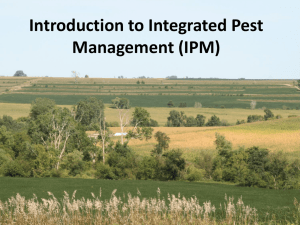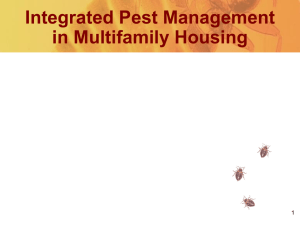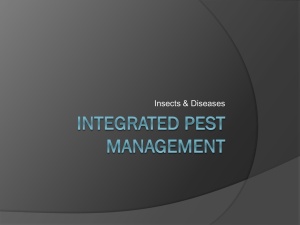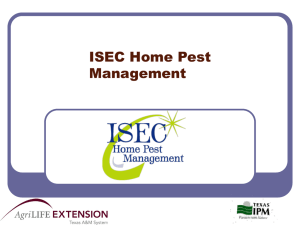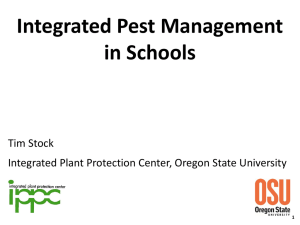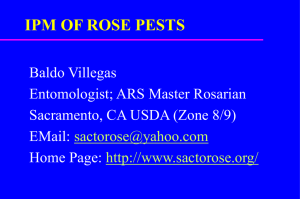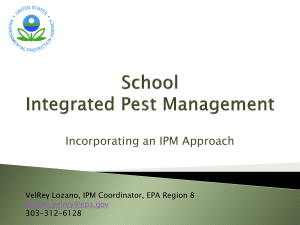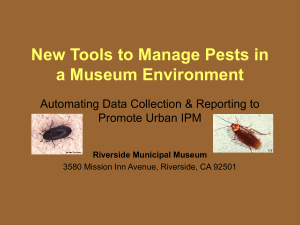Integrated Pest Management and the Case of
advertisement
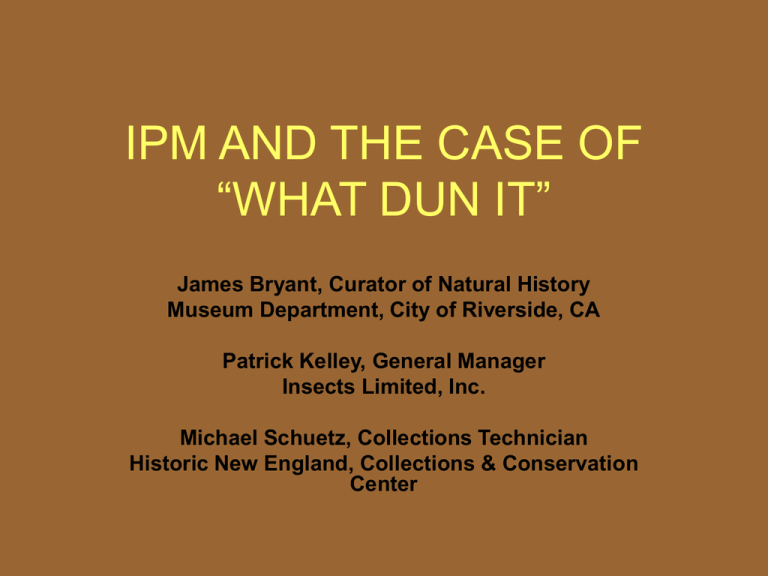
IPM AND THE CASE OF “WHAT DUN IT” James Bryant, Curator of Natural History Museum Department, City of Riverside, CA Patrick Kelley, General Manager Insects Limited, Inc. Michael Schuetz, Collections Technician Historic New England, Collections & Conservation Center IPM and the Case of "What Dun It?" Session Goals: • conceptual introduction to Integrated Pest Management (IPM) • apply what you already know about IPM to a “mystery” scenario • start an inventory of what you may want or need to know about IPM IPM and the Case of "What Dun It?" Outline: •Session Groups go through their scenarios, noting • their Introductions and summary description deductions at each stage, andof Integrateda Pest Management drawing conclusion • Brief intro to the biology and ecology of pest • Reporters review each scenario and species describe their group's findings and • General introduction to pest monitoring and conclusions mitigation measures •• General question and scenarios; commentModerator period Distribution of “mystery” and reporter identified for each group • Conclusion WHAT ARE PESTS? • VERTEBRATES - mice, rats, bats, birds, and squirrels. • INSECTS & OTHER INVERTEBRATES - some merely a nuisance, but may also be agents of destruction; insects are most common and often most difficult pests with which to deal. • MOLD & FUNGI - not pests in the usual sense, but commonly grouped with pests because they are often treated chemically and conditions allowing mold/fungi to form can also be attractive to other pests. WHICH INSECTS ARE PESTS? • • • • PROTEIN FEEDERS (fur, feathers, hide products, wool, silk, bone, etc.) – Carpet Beetles Hide & Leather Beetles, Odd Beetles Case-making & Webbing Clothes Moths Furniture Carpet Beetle, larva and adult Actual adult size 1/10 inch long Odd Beetle adult male Actual size 1/8 inch long Odd Beetle larva WHICH INSECTS ARE PESTS? • • • • • GENERAL FEEDERS (mold, starch, cellulose, grains) – Drugstore Beetles Cigarette Beetles Booklice Silverfish & Firebrats Cockroaches Cigarette Beetle adult Actual size 1/8 inch long Cigarette Beetle larva Actual size 3/16 inch long Adult Booklouse Actual size 1/32 to 3/16 inch long Firebrat Actual size 1/3 to 3/4 inch long WHICH INSECTS ARE PESTS? • • • • • WOOD FEEDERS Furniture Beetles Powder-post Beetles Deathwatch Beetles Carpenter Ants Termites “WHY ARE THEY HERE?” • • • • • • Like humans, pests need food, water, & shelter. Collections storage and historic houses may easily provide for one - or all -of these needs: Climate controlled, stable environment Warmth during cold seasons Higher humidity during dry seasons Quiet, cluttered spaces left undisturbed for long periods Stored quantities of organic material Areas covered by fine, organic dirt & “dust” With things that good, why leave? Integrated Pest Management (IPM): an “ecosystems” approach to pest control that seeks to protect museum staff and visiting public from exposure to toxic chemicals. IPM is “preventative conservation”, i.e. it tries to prevent the conditions in which pests thrive from occurring in museum settings. The “hard work” part: No one person on a museum staff can be responsible for carrying out all IPM methods. Everyone has a role to play. European House Cricket Acheta domestica IPM Program Components • Good housekeeping: producing an environment inhospitable to pests • Integrity of building (excluding pests) • Maintenance (general upkeep of building) • Habitat modification - depriving pests of their optimal environment IPM Program Components Isolation assessment of incoming materials for pest contamination Monitoring & Inspection – regular checking for pests in areas of active/ potential infestation IPM Program Components • Identification & Documentation pest activity records; “What Dun It?” • Treatment action pest control procedures specific to a pest species, site and/or artifact IPM Program Components • Evaluation & Thresholds - determination program effectiveness and “acceptable” levels* of pest infestation • Education - informing staff and the public of methods and benefits of IPM But First… Can You Tell “What Dun It?” • Each table has a pest management case to solve: the stories you will read are true, only the names have been eliminated to protect the innocent. • The Moderator for each table will lead the group through the choices presented in each case, and the Reporter will record those choices. “The Case of the Broken Bat” • Scene 1: You arrive early for your meeting with the mammalogy collections manager. The door from the food service hall into the collections storage room is left open. Closing the door behind you, you notice that a good deal of sound can be heard coming in from the food hall through the space under the door. Whipping out your PDA, you make a note to… • 1) Tell the director it’s ridiculous to have collections storage located next to the food hall • 2) Place a work order with building services to have a tight-fitting sweep attached to the bottom of the door • 3) Place an order with central stores to have an “Out to Lunch” sign purchased for the collection manager’s door “The Case of the Broken Bat” • Scene 2: Entering the mammalogy storage work area, you approach the collection manager’s desk. It seems the collections manager has not gone out to lunch: indeed, a half-eaten sandwich lies atop papers on the desk, and steam rises from a freshly poured cup of java. A small bird flutters away through the open window above the desk. Continuing your notes, you … • 1) Jot down a memo to the Director to have all work spaces removed from collections storage areas • 2) Enter a reminder to discuss a new policy regarding consuming food at work spaces • 3) Place an order with building services to have a fine mesh screen installed in the window over the collections manager’s desk “The Case of the Broken Bat” • Scene 3: Where could the collections manager have disappeared to? Turning away from the desk, you walk down the closest range of storage cabinets. You soon come to an open cabinet with a protruding drawer. In the drawer rests a tray with a specimen that may have once been a bat; the wings of the bat are now a fine mesh of holes. At this point, it looks like… • 1) The collections manager, handling a request that came in during lunch, discovered a specimen that could have been destroyed by pest infestation • 2) The last person to use the cabinet must have left the door and drawer open • 3) In despair upon discovering the infestation, the collections manager leapt out the window • 4) All of the above “The Case of the Broken Bat” • Scene 4: Your attention turns to the “broken bat”. You notice a fine brown powder scattered on the floor of the tray beneath the specimen. Within the powder you find a small number of what appear to be the cast-off husks of some tiny creature, less than 1/8 inch long. Examining these husks you note the following features: • A light tan color • A many-segmented structure, resembling accordion pleats • Numerous, curving bristles surrounding each segment WHAT DUN IT? Odd Beetle larva “The Case of the Devoured Duck” • Scene 1: Late on Monday afternoon, you enter the textile storage room to pull objects for a traveling exhibit. As you reach for a box stuffed deep into a shelf, you accidentally step onto something on the floor that sticks to your foot. You soon realize you have stepped into one of those annoying sticky traps that your predecessor placed throughout the room. Pulling it from your foot, you see what appear to be “bugs” stuck in the glue next to your shoe’s tread mark. Feeling pressured from your new job you should… “The Case of the Devoured Duck” You Should… • 1) Gently replace the smashed glue trap and hope that no one can identify you from your shoe treads. • 2) Salvage what you can from the damaged trap and take it to someone that may be able to identify the “bugs”. • 3) Make a mental note to have housekeeping perform a sweep of textile storage to pick up these disgusting things. “The Case of the Devoured Duck” • Scene 2: When you look up from your feet, you realize that there are 3 or 4 insects sitting stationary on the wall only a few feet from the shelf that you were working in. Not even sure if they are alive you reach for one. Before you can touch it, it hops away from your hand, flies for a short distance and quickly runs into a shadowed area. Not being one who cares much for creepy crawlers you brace yourself and…. “The Case of the Devoured Duck” • Not being one who cares much for creepy crawlers you brace yourself and…. • 1) Say to yourself, this is a bad ending of a bad day, I’m going home. • 2) Immediately start to scratch vigorously on areas of your upper torso. • 3) Find a glass jar with a screw lid that used to hold sewing pins and carefully trap one of the buggers against the wall and close the lid over it. • 4) Both 2 & 3 “The Case of the Devoured Duck” • Scene 3: Looking closely at the insect in the jar, you determine that it looks more like a moth than it does a beetle or a fly. It is a solid cream color and the tips of the wings are feathered kinda like Farrah Fawcett’s hair. It is a little more than a ¼ in long. Your mind wanders back to the sticky trap and the thought occurs to you… “The Case of the Devoured Duck” • Your mind wanders back to the sticky trap and the thought occurs to you… • 1) Monitoring for insects in sticky traps might just work. • 2) I really need to scrape that glue off of my shoe before I go out tonight. • 3) Perhaps the bug in the jar is the same as the ones in the traps. • 4) Both 1 & 3 “The Case of the Devoured Duck” • Scene 4: You retrieve the objects you came for in the first place, in particular a box labeled “duck feather boa”. As you open the box, the smell of your grandmother’s attic hits you in the face and momentarily kicks in a memory of fighting with your brother when you were 10 years old. A spider-webby material is sticking to the inside of the box and covering a portion of the boa. Much of the boa is missing or badly damaged. You note the following other clues… “The Case of the Devoured Duck” • Small skinny white worms with brown heads are crawling on the inside of the box. • A few of the bugs fly out of the box right past your face as you pick up the boa to examine. • Dirty oblong tubes a little larger than the worms are sticking to the remnants of the feathers. These tubes are covered with pepper-like material the same color as the feathers. WHAT DUN IT? “The Case of the Holy Table” • Scene 1: On Friday evening you are making the closing rounds through your institution’s most popular historic house, located on the water in Gloucester, Mass. (You are hurrying to meet your co-workers for a much-needed after-work beer.) In one of the rooms, known as the ‘Pine Kitchen,’ you notice what looks like a ‘pile’ of dust on the floor alongside a table, a 17th century piece made of oak. Taking a closer look, it is indeed a pile of dust, and looks a lot like fresh sawdust. Being tired, late, and thirsty you decide to… • 1) Brush the dust underneath the hooked rug lying next to the table and call it a day. • 2) Get angry and decide to ‘chew out’ your staff for doing a poor job on housekeeping. • 3) Take a closer look and write yourself a note to further inspect the situation when you come in on Monday morning. • 4) Make sure to tell the contractors, who are working on the house, to ‘not track their dust inside.’ “The Case of the Holy Table” • Scene 2: Early Monday morning you remember to look at the ‘Pine Kitchen’ table again. Getting down on your hands and knees, you look at the dust on the floor and notice a number of very small, round holes in the table leg. Further along the leg, you see more holes and what look like ‘tunnels’ running along the wood grain; these tunnels are packed with more dust. You rub the dust between your fingers, noting its slightly gritty texture. Looking at the other table legs you see more holes, tunnels, and dust. You let out a sigh and think to yourself…. • 1) “I hate Mondays’ and ”I really need another beer”. • 2) “Get a magnifying glass and closely inspect the holes and tunnels.” • 3) “It’s just as well; I didn’t really like this table anyway.” • 4) “Take some reference photos, vacuum all of the dust, and keep an eye on the holes.” • 5) “Plug the holes and tunnels with wood fillerpreferably one that matches the color of the oak.” “The Case of the Holy Table” • Scene 3: You tell the Collections Manager about the table and your findings. He says, ‘Hmmm. Last year, rafters in our house had something like that. My cousin looked at it and told me that some kind of worm was eating the wood, that the sawdust is the worms’ fecal waste. Kind of gross, eh?’ Scratching your head, you think…. • “I should go to: • www.museumpests.net/ 1) “Oh, no! I just touched worm fecal and sign upwaste!!” on the • pestlist@museumpests.net 2) “If I used a stethoscope and ‘listened’ to the table, mailing list and post my I might hear chewing, munching questions.” or tapping sounds.” • 3) “Coating the table with clear urethane would ‘seal off’ the worm activity. (The Collection Manager’s ‘bug expert’ said it got rid of the worms in the rafters!)” • 4) “Spray the table with Heavy Duty Insect Killer, making sure to spray inside all the holes and tunnels.” “The Case of the Holy Table” • Scene 4: You come back three days later and see what looks like more piles of sawdust on the floor. You get back down on your hands and knees, you peer into the holes and you see a bug crawl out of a hole! This critter … • Is about 3/8” long, cylindrical body, with parallel rows of pits on its wing covers. • Is medium-brownish in color. • Has what looks like a ‘dome-like’ shell for a head. WHAT DUN IT? Figuring out “What Dun It” is the first (and often the most valuable) step in using an IPM program strategy to solve complex pest issues.
